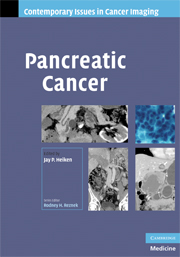Book contents
- Frontmatter
- Contents
- Series Foreword
- Preface to Pancreatic Cancer
- Contributors
- 1 Epidemiology and genetics of pancreatic cancer
- 2 Pathology of pancreatic neoplasms
- 3 Multi-detector row computed tomography (MDCT) techniques for imaging pancreatic neoplasms
- 4 Magnetic resonance imaging (MRI) techniques for evaluating pancreatic neoplasms
- 5 Imaging evaluation of pancreatic ductal adenocarcinoma
- 6 Imaging evaluation of cystic pancreatic neoplasms
- 7 Imaging evaluation of pancreatic neuroendocrine neoplasms
- 8 Role of endoscopic ultrasound in diagnosis and staging of pancreatic neoplasms
- 9 Surgical staging and management of pancreatic adenocarcinoma
- 10 Treatment of locally advanced and metastatic pancreatic cancer
- 11 Rare pancreatic neoplasms and mimics of pancreatic cancer
- Index
- Plate section
- References
6 - Imaging evaluation of cystic pancreatic neoplasms
Published online by Cambridge University Press: 23 December 2009
- Frontmatter
- Contents
- Series Foreword
- Preface to Pancreatic Cancer
- Contributors
- 1 Epidemiology and genetics of pancreatic cancer
- 2 Pathology of pancreatic neoplasms
- 3 Multi-detector row computed tomography (MDCT) techniques for imaging pancreatic neoplasms
- 4 Magnetic resonance imaging (MRI) techniques for evaluating pancreatic neoplasms
- 5 Imaging evaluation of pancreatic ductal adenocarcinoma
- 6 Imaging evaluation of cystic pancreatic neoplasms
- 7 Imaging evaluation of pancreatic neuroendocrine neoplasms
- 8 Role of endoscopic ultrasound in diagnosis and staging of pancreatic neoplasms
- 9 Surgical staging and management of pancreatic adenocarcinoma
- 10 Treatment of locally advanced and metastatic pancreatic cancer
- 11 Rare pancreatic neoplasms and mimics of pancreatic cancer
- Index
- Plate section
- References
Summary
Introduction
Cystic lesions of the pancreas have been increasingly diagnosed in recent years and often are discovered at a smaller size than in the past due to increased awareness and improved diagnostic imaging technology. Although all pancreatic tumors, including ductal adenocarcinomas, may undergo central necrosis and appear predominantly cystic, the term cystic neoplasms usually is applied to epithelial lined neoplastic cysts.
Pancreatic cystic neoplasms are classified mainly on the basis of their epithelial lining and encompass a wide spectrum of different pathologic entities. Serous cystic neoplasm (SCN), mucinous cystic neoplasm (MCN) and intraductal papillary mucinous neoplasm (IPMN) account for more than 90% of these cases. The remaining 10% are represented by solid pseudopapillary epithelial neoplasm (SPEN), cystic pancreatic endocrine neoplasms (PEN), acinar cell cystadenocarcinomas, cystic metastases, and a few other even rarer tumors [1].
The clinical presentation of pancreatic cystic neoplasms is variable, and a substantial number of pancreatic cysts are discovered incidentally during imaging work-up for an unrelated medical problem. When symptomatic, patients often present with abdominal pain, early satiety, vomiting or jaundice. Occasionally they can present with recurrent pancreatitis when the lesion obstructs or communicates with the pancreatic duct. Advanced cystic malignancies may present with symptoms similar to pancreatic adenocarcinoma, i.e. pain, weight loss and jaundice [1–3].
Many cystic pancreatic masses are resected surgically because of the recognized malignant potential of some cystic neoplasms. However, cystic pancreatic neoplasms represent a spectrum from benign to malignant, and benign lesions are recognized with increasing frequency.
- Type
- Chapter
- Information
- Pancreatic Cancer , pp. 83 - 103Publisher: Cambridge University PressPrint publication year: 2008



